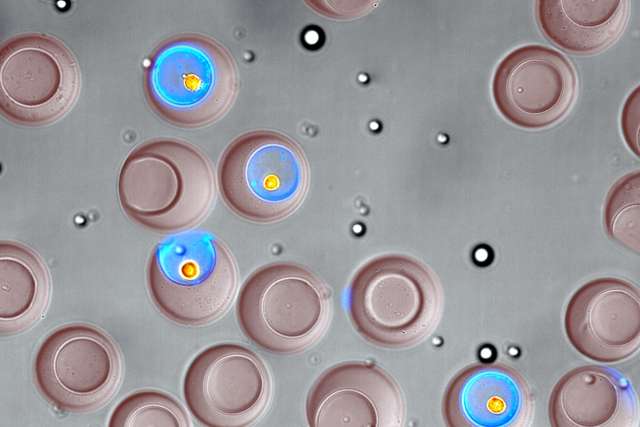FINDINGS
A recent UCLA study demonstrates a new process for screening T cells, part of the body’s natural defenses, for characteristics vital to the success of cell-based treatments. The method filters T cells based on the receptor proteins found on their surface — which enable them to latch onto certain threats — and the type and amount of cell-killing or immune response-triggering molecules that they secrete.
The researchers discovered three previously unidentified, naturally occurring T-cell receptors that target prostate cancer using their screening method. In validation tests, T-cell receptors associated with the highest levels of secretion were the most likely to elicit a response against cancer cells. Rate of functional T-cell receptors was around tenfold higher than using previous techniques.
BACKGROUND
Immunotherapy, treatment that harnesses the body’s natural defenses, is an ever-growing subject of research into cancer and other severe illnesses. The potential of engineered T cell-based immunotherapies comes in part from their ability to narrowly target signatures of disease that are “recognized” by genetically engineered receptors. Since 2017, seven therapies deploying immune cells have gained approval from the Food and Drug Administration to treat blood and skin cancers.
METHOD
The scientists used nanovials, microscopic bowl-shaped hydrogel containers developed at UCLA. Inside, the containers are customized to include specially shaped molecules that enable each to trap one cell plus selected secretions. Nanovials are available commercially from Partillion Bioscience, a company co-founded and run by some of the researchers.
The team first evaluated a population of 20 million T cells sourced from one healthy patient’s blood sample. Different groups of nanovials had targets associated with different common viruses. This study validated the ability for nanovials to find T cells, and their receptors, that react to viruses.
A second experiment with a different patient applied the technology to a much more challenging problem: rare prostate cancer targets the scientists had identified in previous studies. Importantly, those molecular targets acted to both capture the T cells and cause them to secrete certain molecules that kill target cells. In other experiments, the nanovials also had molecules allowing each to capture more than one type of immune-activating secretion.
IMPACT
The three never-before-seen receptors for prostate cancer found in this research could ultimately lead to new tumor-fighting immunotherapies. The ability to select T cells that both bind to a disease-related target and secrete plenty of molecules that trigger an immune response — displayed in the study — is expected to provide major advantages for uncovering additional new disease-targeting receptors, developing cellular therapies and translating those therapies to benefit patients. Using standard lab techniques to label and analyze the nanovials and their contents means that more researchers can apply the new technique.
AUTHORS
The team was led by members of the or CNSI, and the corresponding authors Dr. Owen Witte, University Professor and Presidential Professor of Developmental Immunology at the and Dino Di Carlo, Armond and Elena Hairapetian Professor of Engineering and Medicine in the Both are also members of the . The study’s co-first authors are Doyeon Koo and Zhiyuan Mao, both of whom earned doctoral degrees from UCLA in 2023. Other co-authors are Robert Dimatteo, Miyako Noguchi, Natalie Tsubamoto, Jami McLaughlin, Wendy Tran, Sohyung Lee, Donghui Cheng, Joseph de Rutte and Giselle Burton Sojo, all of UCLA.
DISCLOSURES
Joseph de Rutte is an employee of Partillion Bioscience, which is commercializing nanovial technology. De Rutte, Dino Di Carlo and the University of California have financial interests in Partillion Bioscience. Owen Witte currently has consulting, equity and/or board relationships with Trethera Corporation, Kronos Biosciences, Sofie Biosciences, Breakthrough Properties, Vida Ventures, Nammi Therapeutics, Two River, Iconovir, Appia BioSciences, Neogene Therapeutics, 76Bio and Allogene Therapeutics. Some of the authors are inventors on patent application owned by the University of California.
JOURNAL
The study was published in the
FUNDING
The study was supported by the National Institutes of Health, the National Cancer Institute-funded the Parker Institute for Cancer Immunotherapy, the at the CNSI and the CNSI Mann Family Foundation Technology Development Fund.





